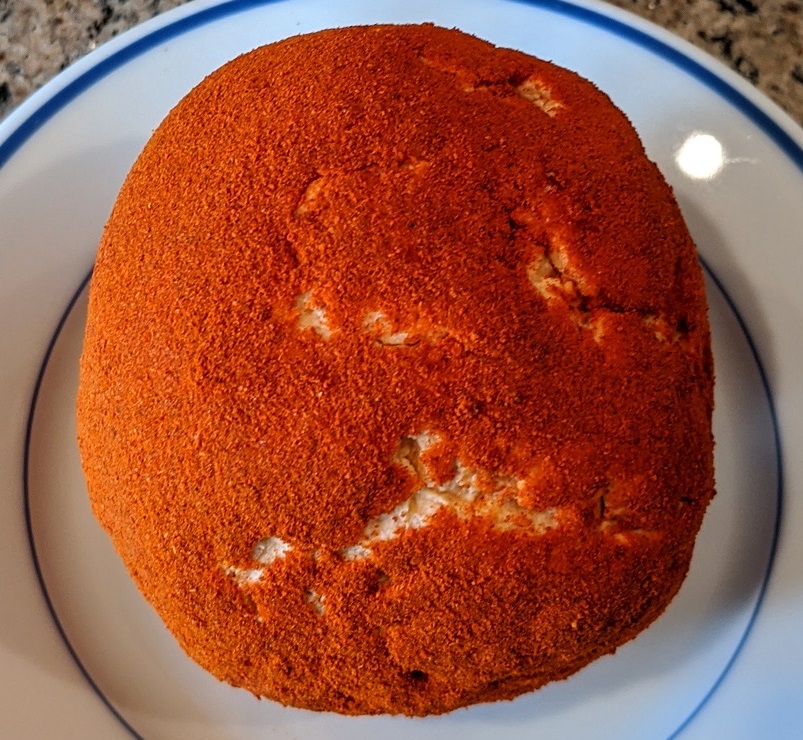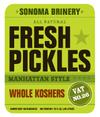|
I’ve been doing Dry January this year. One thing I missed was something for apéro hour, a beverage to mark the start of the evening. Something complex and maybe bitter, not like a drink you’d have with lunch. I found some good options. Ghia sodas are my favorite. Ghia is an NA apéritif based on grape juice but with enough bitterness (gentian) and sourness (yuzu) to be interesting. You can buy a bottle and mix it with soda yourself but I like the little cans with extra flavoring. The Ginger and the Sumac & Chili are both great. Another thing I like are low-sugar fancy soda pops. Not diet drinks, they still have a little sugar, but typically 50 calories a can. De La Calle Tepache is my favorite. Fermented pineapple is delicious and they have some fun flavors. Culture Pop is also good. A friend gave me the Zero book, a drinks cookbook from the fancy restaurant Alinea. This book is a little aspirational but the recipes are doable, it’s just a lot of labor. Very fancy high end drink mixing, really beautiful flavor ideas. The only thing I made was their gin substitute (mostly junipers extracted in glycerin) and it was too sweet for me. Need to find the right use for it, a martini definitely ain’t it. An easier homemade drink is this Nonalcoholic Dirty Lemon Tonic. It’s basically a lemonade heavily flavored with salted preserved lemons, then mixed with tonic. I love the complexity and freshness of this drink and enjoy it on its own merits. Finally, non-alcoholic beer has gotten a lot better in the last few years thanks to manufacturing innovations. I’ve been enjoying NA Black Butte Porter, Stella Artois 0.0, Heineken 0.0. They basically all taste just like their alcoholic uncles, no compromise. One thing to note about non-alcoholic substitutes is they are not cheap. They’ve become a big high end business. Expect to pay the same for an NA drink as one with alcohol even though they aren’t taxed nearly as much. I joined the Instant Pot religion. I mostly use it as a pressure cooker, but the fact you can also saute and brown things in it, simmer them, etc makes it really versatile. The cooking modes are confusing though and the pressure cooker is lower pressure than typical American electric pressure cookers. Here’s a cheat sheet to temperatures for the Instant Pot. I believe these come from the official manual. There’s also great detail in this review.
Note that simmering means to keep the pot just below 100°C. It’s not quite boiling, but there’s still a little steam nucleation which makes the tiny bubbles. In an Instant Pot that means Slow Cook on Medium or High, probably with the lid off. A favorite indulgent potato chip dip. It's the mild egg flavor with a bit of smoke makes this special. We generally have it as a holiday treat but there's nothing particularly Christmassy about it. Ken says he got the recipe from someone who worked with his Mom around 1960.
Chop the eggs in a food processor fairly fine. Put the cream cheese into a wide, shallow bowl. Add the eggs and mayonnaise and mix well with a fork. Add the remaining seasonings and mix again. Enjoy with your favorite chips. This is a mild dip so plain or mild flavored chips are a better choice. I posted this recipe three
years ago but that was me trying to reconstruct it; this better
version is from Ken's own hand.
One of my mother’s favorite Christmas recipes dating back to at least the 1970s were her cheese balls. Nothing unique about the cheese ball or cheese log for Christmas. But ours were specifically Texan. I have a photograph of her recipe card, here’s the ingredients. I think things in parentheses were variants. Cheese ball (3 fist size balls)
Her recipe didn’t include any notes on actually making it, but it’s basically "put it all in a bowl and mash it together". Grate the cheddar first (she used a sharp cheddar) and don’t be afraid to use your hands to mush it all together. To finish she would roll the balls in bright red mild paprika, mostly for the color. Sometimes in pecans but I never much cared for that. What makes this Texan? The sharp cheddar, the liquid smoke, and the garlic/onion/cayenne that are chili seasonings. All it’s missing is cumin! (Don’t use cumin.) The prepared mustard is a bit of a curveball for a Texas dish but it’s good. And the touch of wine adds a sophistication. I was reminded of this because Homesick Texan just posted her Aunt Betty’s cheese ball recipe. That recipe is similar to my mom’s but there are some interesting differences. I like Fain's Worcestershire and the idea of rolling in chili powder (itself a spice blend, including cumin). Wouldn’t be my Mom’s though without the liquid smoke and I suspect the prepared mustard is doing some magic not in Fain’s recipe. I wonder at the history that gives us these two similar Texas cheese ball recipes. Knowing my mom I’m guessing it was Helen Corbitt. Indeed Corbitt has a cheese ball recipe involving mustard and smoked cheese. And horseradish and pickled beets?! Maybe not. Update: just made this and it's as good as I remember. Mix the (scant) non-cheese ingredients first, then mash that into the cream cheese, and only at the end add the cheddar. The finer grated the cheddar is the better, but don't use pre-grated; the grocery store stuff is coated with anti-caking powder. I mixed with my bare hand, the warmth helping melt the cream cheese, then froze it for half an hour to shape. Update 2024: still good! The shaping is tricky. Roll the cheese into a ball with a water-wet hand on a counter to get it smooth. Then use your wet hand to roll half the ball in paprika on a cutting board. Then use your dry hand to handle the paprika-coated side and finish rolling to fully cover.  I’ve learned to make a simple Korean stew that’s delicious and foolproof. Doenjang Jjigae (된장찌개) is a homey stew made with a flavor of fermented soybean paste, something like miso only more rustic and spicy. Serve it over rice with some banchan (side-dishes) and you have a simple reliable meal. There’s a zillion different recipes online. Maangchi’s recipe is good or see here for a second opinion. The core flavor comes from the broth made from doenjang paste dissolved in water. The broth is easy since the flavor comes from a pre-prepared product. You can find doenjang in Asian groceries or at a markup on Amazon. Garlic and chile is added to the broth for heat and flavor. Korean ground red chile is best (Amazon) or you can use most anything; red pepper flakes, cayenne, maybe some hot paprika for a bit of smoke. The broth can also be upgraded by starting with anchovy stock instead of plain water. Once you have the broth you add the rest. Common vegetables include zucchini, daikon or mu, onion, fresh chiles, potato. Proteins include tofu, shrimp, clams, or my favorite: fatty pork. You can pretty much just boil everything together, although if you’re using pork you should render the fat first in the pot before making the broth. I serve it in a bowl over short grain rice with whatever side dishes I can muster. A full banchan spread is a ridiculous amount of work. But I almost always have a jar of kimchi on hand. These marinated mushrooms are also super easy to make and delicious. Paprika is good software. It’s a recipe database for home cooking, just like the Honeywell Kitchen Computer. But it doesn’t cost $10,000 and you don’t have to go to Nieman Marcus to buy it; it’ll run right on your own portable telephone. The problem Paprika solves very well is “I want this recipe on my iPhone so I can read it in the kitchen”. It also has good tools for “make me a shopping list for these three meals”, I’ve used that on the fly while standing in the grocery store. The weird thing about Paprika is it’s not a web app. There is no web view of your recipe database. Instead there are iOS and Android apps ($5) and Mac and Windows desktop apps ($20-$30). They’re all linked to some cloud server that stores your recipes. No subscription fee. So the part that’s clumsy is adding new recipes to your database. There’s a way to search and browse from inside the iPhone app that works OK. But mostly I find recipes on my desktop web browser. For that need there’s a bookmarklet which does a fine job of saving the recipe (and nothing else). Behind the scenes the Paprika system scrapes the ingredients and instructions out of the web page and puts them in some normalized format. That’s not easy to do but it’s worked every time for me so far. I’m very happy with the iPhone app and use it regularly when cooking. Ken and I share a database, which seems nice. I haven’t tried the desktop apps nor have I done anything complicated with our database, it’s mostly just Pocket-for-recipes for me. I’m still a bit baffled the business is built the exact opposite of how I would have (web app, charge a subscription fee) but what they’re doing works fine, so why not? One of our holiday treats is an egg dip that Ken makes, an old family recipe. It’s sort of like smoky deviled eggs only potato chip compatible. I like it. Here’s an approximation of the recipe; it’s not an exact thing.
Mince the eggs. Blend with mayo and cream cheese to dip texture. Flavor with mustard, liquid smoke, and salt. The result should taste mostly like eggs, with a noticeable smoky flavor and a bit of sharpness from the mustard. You can use ordinary wet mustard but the dry mustard without vinegar is better. Minced onion or shallot might be a nice addition. Or cayenne pepper. 
There’s two kinds of cucumber pickle in the world: fermented and vinegar. Vinegar pickles are what you generally see in the grocery store, the Claussens and Vlasics. They’re not bad but they are awfully salty and the industrial vinegar is not a very good flavor. Fermented pickles are made without vinegar. Instead the vegetable is salted and then fermented to encourage lactic acid bacteria, which makes the pickles sour. Sonoma Brinery makes an exceptionally good fermented pickle. They’re available in grocery stores in the US west, sold refrigerated. And while they’re not cheap at about $1 a large pickle they are delicious. Great flavor and good snap. They call them “half-sour”. They have a pleasant sour taste but it’s subdued, also the salt level is quite low. The result is a mild, fresh tasting pickle, something I much prefer to Bubbie’s intensely sour and salty fermented pickles. Sonoma Brinery’s fresh sauerkraut is also delicious. Fermented foods are newly trendy thanks to the probiotic food fad (move over, gluten free). I could care less about the fake food science but I am glad that fermented flavors are more widely available in grocery stores. I’m not a fan of kombucha, too expensive and too sweet. But sauerkraut, kimchi, etc are delicious. I’ve started trying to ferment my own things now with Sandor Katz’s excellent book. 
I’ve gotten competent at making pizza at home. It’s an easy versatile meal, 15 minutes prep time once you have the dough. I tend to make a sort of puttanesca pizza: capers, olives, anchovies, sauce from a jar (the shame) and some salami. Today was turkey leftover pizza with white sauce, I regret being too timid to try cranberry sauce after baking. My go-to cookbook is American Pie, specifically the “neo-Neapolitan” dough variant. I’ll make a batch of 5 servings of dough and freeze 4. A stand mixer is a huge help, the dough is very glutenous. I recently learned slicing the mozzerella works better than grating, and so much easier. The dough takes time to ferment, thaw, etc but not much active work. The challenge of home pizza is our ovens don’t go over 550°F. I get decent results in a home oven on a pizza stone, but Ken just got a Baking Steel from Sur la Table so I gave that a shot. It definitely cooks faster and chars the crust more; too much so, the bottom was about to burn before the edge was fully baked. The steel is heavy, rusts, and needs seasoning like a cast iron skillet. I’m not sure it’s a huge improvement over a clay tile. Neapolitan-style pizza dough is pretty tempermental. For something different and foolproof this pan pizza recipe works pretty well. A no-knead dough sort of fried up in a cast iron skillet in the oven. It’s not elegant, more of a fast-food style pizza, but it’s delicious and fresh and that is its own reward. One of the few things I can cook competently is Tex-Mex chili. It’s basically a pot of meat cooked with red chile and onion. No beans, no tomato. Hearty and delicious with tortillas, sharp cheddar, fresh onion, and sour cream garnishes. I’ve learned to make chili from scratch. But if you want to cheat, Wick Fowler’s 2 Alarm Chili Kit is a reasonable compromise. It’s not as good as making it the hard way but it’s still pretty good, particularly if you bump it up with some of your own chile powder. To make it from scratch, I use this Homesick Texan recipe. I love her blog and cookbook. It’s a very fussy recipe but makes an excellent result. Over time I’ve modified it a bit.
I grew up with this kind of food. |
||
